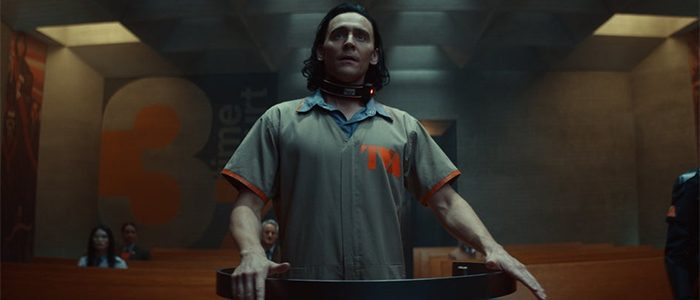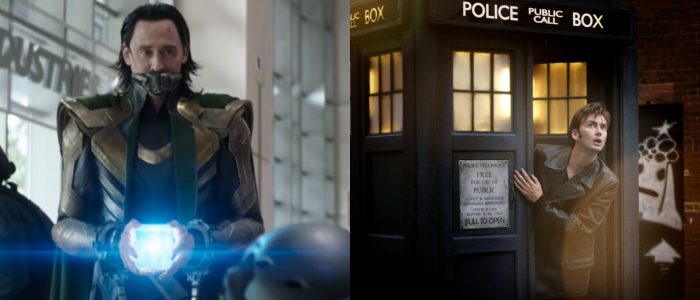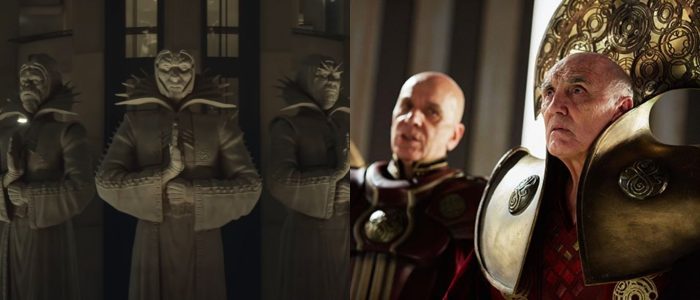
Do you remember how the feverish speculation surrounding the next lead in the legendary science fiction series Doctor Who would always, inevitably land on Tom Hiddleston? Rallying cries of “Tom Hiddleston as the 12th Doctor!” or “Tom Hiddleston should be the 13th Doctor!” frequently circulated the internet, as did fan art that depicted the Avengers star in front of the TARDIS, that blue box in which the Doctor traveled in time and space.
Well, fans kind of got their wish with Loki, the new Marvel series on Disney+ starring Hiddleston as the God of Mischief after he gets arrested by the Time Variance Authority for “crimes against the Sacred Timeline.” A rogueish protagonist who flouts the laws of time? An intimidating organization run by cosmic figures with a penchant for high collared capes? Time travel rules that are a little wibbly-wobbly timey-wimey?
Yes, Loki is basically Marvel’s take on Doctor Who, the long-running BBC sci-fi series about an alien who goes on whimsical adventures in time and space. Loki is a little less whimsical and a lot more higher budget, but the show’s time-hopping plot certainly recalls a few episodes of Doctor Who (it even shares actors, with Gugu Mbatha-Raw having appeared in Doctor Who as Martha Jones’ sister Tish). This is especially true in this week’s episode of Loki, which calls to mind another “Volcano Day” in Doctor Who, but with a very different approach.
This article contains spoilers for the first two episodes of Loki.

The Criminal With the Blue Box
Let’s start first with the most apparent Doctor Who in-joke. In the first episode of Loki, we follow a version of Loki who a refugee from a broken timeline after he escapes the events of Avengers: Endgame with the Tesseract in hand. He’s quickly apprehended by the TVA, which reveals itself to be a cosmic organization that maintains the integrity of “the Sacred Timeline,” AKA the primary Marvel Cinematic Universe timeline. But the people manning that organization seem to be exclusively low-level office grunts, one of which attempts to process Loki’s Tesseract as evidence, but is not given any description by Hunter B-15 and the Minutemen who arrested Loki. Later on, during one of Loki’s many escape attempts, that desk clerk (Eugene Cordero) calls Loki “the criminal with the blue box.”
Now this phrase seems like a direct nod to Doctor Who. If it’s not, it’s a real funny coincidence. Many fans and even non-fans of Doctor Who know that the Doctor travels in space and time in a ’60s police box, a once-common item on the streets of London that has now become a museum piece — except on Doctor Who, where the blue wooden box is frequently seen spinning through the time vortex. The TARDIS, that blue box, is synonymous with Doctor Who.
And the Doctor has been treated as a criminal by his own kind, the Time Lords, before — even getting put on trial for interfering too much in space and time. But speaking of the Time Lords…

Time Keepers or Time Lords?
The Time Variance Authority is basically just a more bureaucratic Gallifrey, right? And the Time-Keepers are essentially the High Council of Time Lords, right down to a preference for high-collared capes. Except, you know, the Time Keepers are space lizards and the High Council is a bunch of stuffy British men. Gallifrey is the Doctor’s home world, from which the Time Lords operate, lording over space and time, and making sure no one interferes too much with the timeline. But of course, there are your fair share of rogue elements, including the Doctor himself, who usually meddles in order to save a planet or civilization — versus Loki’s self-serving motivations.
But the TVA and the Time Lords serve a similar function with wildly different portrayals. The TVA is an ingenious combination of soulless bureaucracy and infinite godlike power — their decor is a dull beige retro look right out of the 1970s, and the overall mood at the TVA is a Kafkaesque tedium that manages to dilute phenomenal concepts into something mundane. The TVA exists outside of space and time and its agents are perhaps the only people in the universe capable of “free will,” as Loki points out. But they choose to read jet-ski magazines or to use Infinity Stones — items that millions of people fought and bled for — as paper weights. It’s a mundanity that lends the TVA even more power, and one that Doctor Who has frequently grasped at in their portrayals of Gallifrey, while often falling shot.
Whether by lack of budget or imagination, the Time Lords at Gallifrey mostly come off as stodgy out-of-touch doofuses, more prone to trip over their ridiculous capes than to display any real power (it’s probably why the new series has frequently shied away from showing Gallifrey in the flesh — sorry to Gallifrey fans, but it’s lame). In the revival series, Doctor Who wisely killed off Gallifrey in the Last Great Time War, and whatever key appearances they would make in the years following were generally disappointing. Gallifrey is much more effective being spoken about in hushed, reverent tones than to actually be seen.
But Loki might have just solved a problem that Doctor Who has long been struggling with. The series just turned Gallifrey into a Terry Gilliam-inspired Office Space.
It’s Volcano Day
Any show dealing with time travel has to operate within a strict set of rules — or just a few rules, and to hell with the rest of them. Loki thus far has introduced a few key ideas: the Sacred Timeline and the concept of “Nexus events,” significant events which can drastically alter the timeline as set by the Time Keepers. The TVA has been charged with identifying Nexus events — which can be as large as starting a war, or as small as being late for work — and stamping them out before they can create a new branch timeline separate from the Sacred Timeline. The figures at the center of Nexus events are called “Variants,” of which our Loki is one.
Doctor Who, despite being a time travel show, has only loosely defined its rules of time travel in recent years, at first going by the rules of “Never interfere!” and eventually devolving to the rules of “There are none!” Then in a 2008 episode, “The Fires of Pompeii,” Doctor Who introduced the concept of “fixed points in time,” moments in time that can never be changed or universe-altering disasters will be incurred. It’s kind of the inverse concept of the “Nexus” event in Loki, but both come to the same result: something must be done to protect this moment or all hell will break loose. Of course, this allows Doctor Who more flexibility to play around in time more compared to Loki, which must strictly adhere to the Sacred Timeline, except, apparently when it comes to apocalyptic events — a loophole discovered by none other than our Loki variant.
And where does he go to prove his point? Pompeii on Volcano Day.
It again has to be pointed out how funny it is that key pieces of time travel lore in both Doctor Who and Loki are introduced in episodes featuring Pompeii — except where Doctor Who treats the event with a sober and compassionate hand (even throwing in a bootstrap paradox to make the Doctor wrestle with being complicit in the death of thousands), Loki treats the whole thing a bit more glibly, with our God of Mischief freeing goats and kicking carts to show Agent Mobius (Owen Wilson) that nothing he does matters when the timeline is about to end in apocalypse.
It’s only been two episodes thus far, but the Loki and Doctor Who similarities are already piling up. Who knows what other time-travel shenanigans Loki has in store for us?
***
Loki airs new episodes Wednesdays on Disney+.
The post ‘Loki’ is Basically Marvel’s Version of ‘Doctor Who’ – And That Rules, Actually appeared first on /Film.
0 Comments